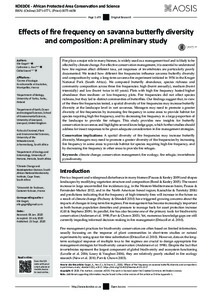Effects of fire frequency on savanna butterfly diversity and composition: A preliminary study
Elie Gaget; Clélia Sirami; Catherine L. Parr
Effects of fire frequency on savanna butterfly diversity and composition: A preliminary study
Elie Gaget
Clélia Sirami
Catherine L. Parr
AOSIS
Julkaisun pysyvä osoite on:
https://urn.fi/URN:NBN:fi-fe2021042824092
https://urn.fi/URN:NBN:fi-fe2021042824092
Tiivistelmä
Fire plays a major role in many biomes, is widely used as a management tool and is likely to be affected by climate change. For effective conservation management, it is essential to understand how fire regimes affect different taxa, yet responses of invertebrates are particularly poorly documented. We tested how different fire frequencies influence savanna butterfly diversity and composition by using a long-term savanna fire experiment initiated in 1954 in the Kruger National Park (South Africa). We compared butterfly abundance, species richness and community composition across three fire frequencies: high (burnt annually), medium (burnt triennially) and low (burnt twice in 60 years). Plots with high fire frequency hosted higher abundance than medium- or low-frequency plots. Fire frequencies did not affect species richness, but they led to distinct communities of butterflies. Our findings suggest that, in view of the three fire frequencies tested, a spatial diversity of fire frequencies may increase butterfly diversity at the landscape level in wet savannas. Managers may need to promote a greater diversity of fire frequencies by increasing fire frequency in some areas to provide habitat for species requiring high fire frequency, and by decreasing fire frequency in a large proportion of the landscape to provide fire refuges. This study provides new insights for butterfly conservation in savannas and highlights several knowledge gaps, which further studies should address for insect responses to be given adequate consideration in fire management strategies.Conservation implications: A spatial diversity of fire frequencies may increase butterfly diversity. Managers may need to promote a greater diversity of fire frequencies by increasing fire frequency in some areas to provide habitat for species requiring high fire frequency, and by decreasing fire frequency in other areas to provide fire refuges.
Kokoelmat
- Rinnakkaistallenteet [19249]
